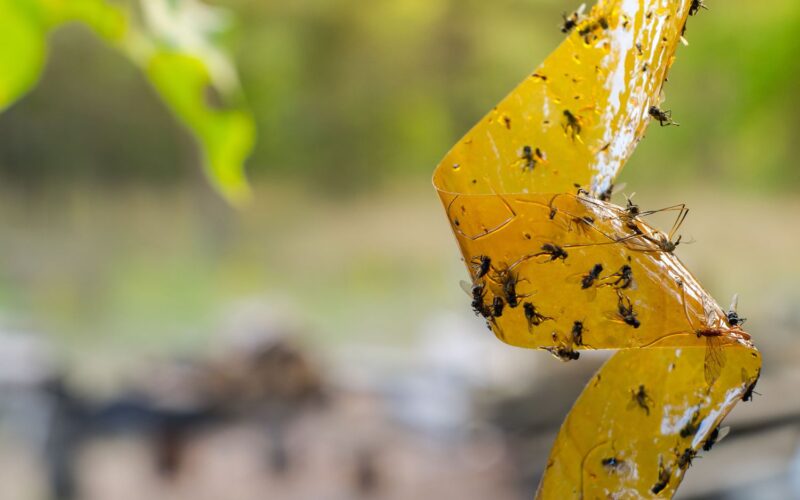If you’re looking for a quick, budget-friendly way to get rid of flies, here’s how to make fly paper with surprisingly effective duct tape. This DIY method is easy, chemical-free, and works great for kitchens, patios, and anywhere flies love to hang out.
In this guide, we’ll show you step-by-step how to make your sticky fly trap using household items, plus tips to get the best results.
Why Choose a DIY Fly Trap?
There are many reasons to make your fly paper at home. For starters, commercial fly traps can be expensive, filled with strong-smelling chemicals, or just not available when you need them most. A homemade trap using duct tape is:
- Cheap (duct tape is in most homes already)
- Non-toxic (safe for kids and pets)
- Fast and easy to make
- Effective in catching flies where they land most
Once you learn how to make fly paper with duct tape, you’ll see just how simple pest control can be.
What You’ll Need
To make your homemade fly paper, gather the following items:
- Duct tape (any brand, preferably wide strips)
- Scissors
- A spoonful of sugar, honey, or syrup (optional, for added attraction)
- A place to hang or place the tape (window, wall, ceiling, or counter)
That’s it! No fancy tools, no harsh chemicals—just basic household supplies.
Step-by-Step: How to Make Fly Paper with Duct Tape
Step 1: Cut the Tape
Start by cutting strips of duct tape around 8 to 12 inches long. You can adjust the length based on where you plan to hang or place them. The sticky side of the tape will be exposed to trap the flies.
Step 2: Fold One End for Easy Removal
At one end of each strip, fold about half an inch of the sticky side back onto itself to create a small tab. This makes it easier to handle, hang, or remove the trap later.
Step 3: Add Bait (Optional but Effective)
To attract more flies, lightly smear a small amount of sugar, honey, or syrup onto the sticky side of the tape. This adds scent and sweetness, making your fly paper even more tempting for flies to land on.
Step 4: Hang or Place the Tape
Place the duct tape in areas where flies are most active, near windows, trash cans, sinks, or fruit bowls. You can hang the tape from the ceiling using thumbtacks or tape the ends to the walls or cabinets.
Step 5: Monitor and Replace
Within a few hours, you’ll start to see results. Once the tape is covered with flies or dust, simply remove and replace it with a fresh strip.
How Does It Work?
The secret behind how to make fly paper with duct tape is simple: flies are naturally drawn to light, smells, and sugary substances. The sticky surface of the duct tape traps them instantly once they land. When you add bait like honey or syrup, it increases the chances of attracting them faster.
The tape’s strong adhesive is more than enough to hold flies in place, making this method just as effective as store-bought sticky traps, without the high price tag or harsh chemicals.
Where to Use Your Homemade Fly Paper
Your homemade fly paper can be used in several areas around your home:
- Kitchen: near fruit, trash, or sinks
- Dining Room: near windows or doors
- Bathroom: especially if there’s standing water
- Outdoor spaces: on patios or near pet food
Just make sure to keep it out of direct contact with food or where children or pets might touch it. The goal is to trap flies, not cause messes!
How Often Should You Replace It?
You should replace your fly paper when:
- The surface is full of trapped flies
- It’s covered in dust or dirt
- The bait has dried out
- After 3–5 days of use for best effectiveness
Fresh tape catches flies faster, so don’t be afraid to make and use several strips around your home.
Bonus Tips to Keep Flies Away
While learning how to make fly paper with duct tape is a great first step, prevention is always better than a cure. Here are a few extra tips to reduce flies in your home:
- Keep your kitchen clean and dry
- Take out the trash regularly
- Store food in sealed containers
- Fix leaky faucets and remove standing water
- Use screens on windows and doors
Combining these habits with your DIY fly paper ensures better long-term results.
Final Thoughts: Simple, Smart, and Effective
Now you know how to make fly paper with duct tape, a budget-friendly, fast-acting solution to fight off those annoying flies. This simple method uses everyday items, takes less than 10 minutes to prepare, and delivers real results without any fancy gadgets or chemical sprays.
Whether it’s summertime fly season or you just left the door open too long, a roll of duct tape might be the only fly trap you need.
